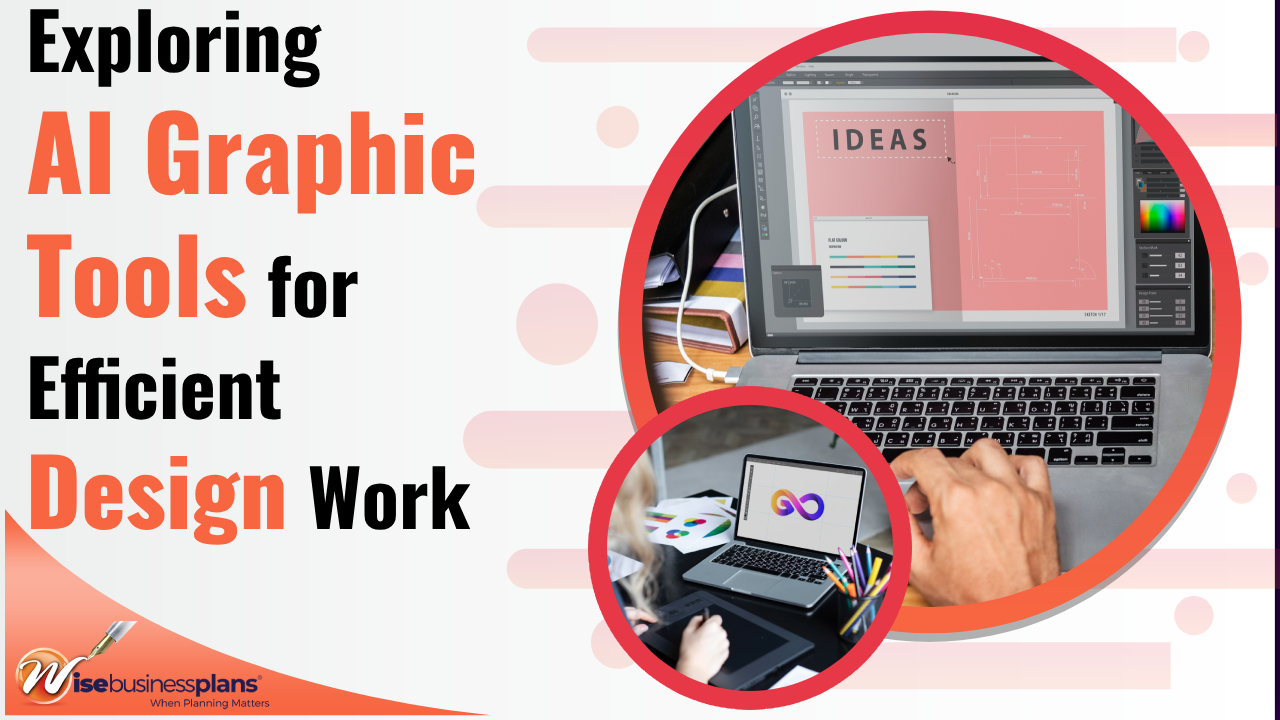Exploring AI Graphic Tools for Efficient Design Work
Table of Contents
- The Benefits of AI in Graphic Designing
- How Artificial Intelligence Revolutionising the Graphic Design Industry
- 1. Canva
- Pros
- Cons
- 2. Figma
- Looking for a business plan writer?
- Pros
- Cons
- 3. Designs.ai
- Pros
- Cons
- 4. Let’s Enhance
- Pros
- Cons
- 5. Piktochart
- Pros
- Cons
- 6. Easil
- Pros
- Cons
- 7. Visme
- Pros
- Cons
- 8. Pixlr X
- Pros
- Cons
- 9. Venngage
- Pros
- Cons
- 10. VistaCreate
- Pros
- Cons
- 11. BeFunky
- Pros
- Cons
- Want to write a business plan?
- 12. Vecteezy
- Pros
- Cons
- Conclusion
- AI Tools for graphic Design: FAQs:
In today’s digital age, graphic design has become an integral part of various industries, from marketing and advertising to content creation and brand identity. As technology advances, AI tools for graphic design have emerged, revolutionising the way designers create visual content. In this blog post, we will delve into a selection of AI graphic tools that are making waves in the design community, providing users with innovative features and streamlining the design process.
The Benefits of AI in Graphic Designing
Artificial Intelligence (AI) has revolutionized the field of graphic designing, offering a multitude of benefits that enhance creativity, streamline workflows, and deliver exceptional visual experiences. Here are some key advantages of AI in graphic designing:
- Automation of Tasks:
- AI automates repetitive and time-consuming tasks, freeing up designers to focus on creative work.
- Tasks like resizing, font selection, and design variations are efficiently handled by AI algorithms.
- Intelligent Assistance and Inspiration:
- AI-powered tools analyze design data and trends, providing recommendations for colors, fonts, and layouts.
- Designers receive intelligent assistance, empowering them to create visually appealing and trendy designs.
- Streamlined Collaboration:
- Real-time collaboration platforms powered by AI facilitate simultaneous teamwork from different locations.
- Features like version control and feedback systems improve project efficiency and communication.
- Improved Quality and Consistency:
- AI algorithms analyze design elements, compositions, and aesthetics, offering real-time feedback for improvements.
- Designs meet industry standards, client expectations, and maintain consistency across projects.
- Personalized and Data-Driven Designs:
- AI leverages user data and preferences to generate customized designs for specific target audiences.
- Analyzing user behavior and demographics enables designers to create more engaging visuals.
- Efficient Design Generation:
- AI algorithms generate multiple design options based on input preferences, accelerating the ideation process.
- Designers gain a starting point or inspiration for their projects.
- Expanding Design Possibilities:
- AI introduces new tools and techniques like generative design, AR, and VR.
- Complex designs, interactive visuals, and immersive experiences push the boundaries of graphic design.
How Artificial Intelligence Revolutionising the Graphic Design Industry
- Automation of Repetitive Tasks:
- Efficient handling of resizing, font selection, and design variations.
- Saves time and enhances productivity for designers.
- Intelligent Assistance and Inspiration:
- AI-powered tools analyze design data and trends.
- Provides recommendations for color palettes, fonts, and layout options.
- Empowers designers with creative insights and trendy design elements.
- Streamlined Collaboration:
- Real-time collaboration platforms powered by AI.
- Enables simultaneous teamwork from different locations.
- Features like version control and feedback systems improve project efficiency.
- Improved Quality and Consistency:
- AI algorithms analyze design elements and aesthetics.
- Real-time feedback and suggestions for design improvements.
- Ensures high-quality designs that meet industry standards and client expectations.
- Personalized and Data-Driven Designs:
- AI leverages user data and preferences.
- Generates customized designs for specific target audiences.
- Enhances user engagement and conversion rates with tailored visuals.
- Accelerated Design Generation:
- Input preferences to generate multiple design options.
- Speeds up the ideation process and provides design inspiration.
- Introducing New Tools and Techniques:
- AI-powered generative design, AR, and VR.
- Complex designs, interactive visuals, and immersive experiences.
- Expands the boundaries of traditional graphic design.
Looking for logo design service?
Get a quote now!
1. Canva
Canva is a popular online graphic design platform that has gained immense popularity among designers and non-designers alike. With its vast collection of templates, design elements, and editing tools, Canva allows users to effortlessly create stunning graphics for social media, presentations, posters, and more. Its user-friendly interface and intuitive features make it accessible to individuals with varying levels of design expertise. Paying strategy Canva offers both free and paid subscription plans. While the free plan provides access to a wide range of design elements and templates, Canva also offers a paid subscription called Canva Pro, which provides additional features and benefitsPros
- Extensive template library for various design purposes
- User-friendly interface, making it accessible to beginners
- Collaboration features, allowing multiple users to work on designs simultaneously
- Free plan with a wide range of design elements and templates
- Canva Pro offers additional features like resizing, branding, and team collaboration
Cons
- Limited customization options compared to professional design software
- Canva Pro subscription required for advanced features and benefits
- Some design elements and templates may appear generic due to their popularity
2. Figma
Figma stands out as a collaborative design tool that has gained recognition for its real-time design and prototyping capabilities. With Figma, teams can work together seamlessly, simultaneously editing and commenting on design projects. The tool offers features such as design components, version control, and interactive prototyping, empowering teams to create and iterate designs efficiently.
Paying strategy
Figma offers a free plan that allows users to create and collaborate on designs. However, they also offer a paid subscription called Figma Professional, which provides advanced features like team libraries, unlimited version history, and more.

Looking for a business plan writer?
Hire a professional business plan writer now!
Pros
- Real-time collaboration, allowing multiple users to edit and comment simultaneously
- Design components and libraries for consistent and efficient design workflows
- Interactive prototyping for user experience testing
- Free plan available for individual users and small teams
- Figma Professional offers advanced features like unlimited version history and team libraries
Cons
- Steeper learning curve compared to some other graphic design platforms
- Offline access and desktop app limited to the paid plan
- Complex projects with a large number of design components may experience performance issues
3. Designs.ai
Harnessing the power of AI, Designs.ai offers a comprehensive design platform encompassing graphic design, video editing, and branding. The platform’s AI algorithms drive various features, including logo design, video creation, mockup generation, and social media post creation. Designs.ai enables designers to expedite their workflow by automating repetitive tasks and offering intelligent design suggestions.
Paying strategy
Designs.ai offers both free and paid subscription plans. The free plan provides access to basic design features, while the paid plans, such as the Premium and Enterprise plans, offer more advanced features and additional design assets.
Pros
- AI algorithms that expedite the design process and offer intelligent suggestions
- Multiple design capabilities, including logo design, video creation, and mockup generation
- Free plan with basic design features
- List Item #1
- Premium and Enterprise plans offer more advanced features and additional design assets
Cons
- AI-generated designs may lack the creativity and personal touch of human-designed content
- Limited flexibility compared to platforms that allow more manual customization
- Complex design requirements may require additional graphic design software
4. Let’s Enhance
Let’s Enhance is an AI-based image upscaling and enhancement tool that has garnered attention for its ability to improve image quality while preserving crucial details. Using advanced machine learning algorithms, Let’s Enhance allows designers to enlarge images without sacrificing resolution or introducing pixelation. It’s a handy tool for enhancing photographs or graphics while maintaining their visual integrity.
Paying strategy
Let’s Enhance offers both free and paid plans. The free plan allows users to enhance a limited number of images per month, while the paid plans, such as the Plus and Pro plans, offer more image enhancement capabilities.
Pros
- Ability to enhance image quality and preserve crucial details
- Enlarging images without sacrificing resolution or introducing pixelation
- Easy-to-use interface for quick and efficient image enhancements
- Free plan available with a limited number of image enhancements
- Plus and Pro plans offer more image enhancement capabilities
Cons
- AI algorithms may not always produce the desired results for complex image enhancements
- Limited control over the specific aspects of image enhancement compared to manual editing
- Higher-resolution enhancements may require a paid subscription
5. Piktochart
For those seeking to create informative and visually compelling infographics, presentations, and visual content, Piktochart is an invaluable resource. The platform offers a drag-and-drop interface, customizable templates, and an extensive library of icons, images, and charts. Piktochart simplifies the creation of engaging visual content, even for users without a design background.
Paying strategy
Piktochart offers both free and paid plans. The free plan provides access to basic features and templates, while the paid plans, such as the Pro and Team plans, offer additional customization options, premium templates, and collaboration features.
Pros
- Simplified creation of informative and visually compelling infographics
- Extensive library of customizable templates, icons, and images
- User-friendly interface suitable for individuals without a design background
- Free plan with basic features and templates
- Pro and Team plans offer additional customization options and collaboration features
Cons
- Limited design capabilities compared to more advanced graphic design software
- Some templates and design elements may feel generic due to their popularity
- Customization options may be limited for users with specific design requirements
6. Easil
Easil specializes in creating visual content for social media platforms. With its collection of templates, fonts, images, and other design elements, Easil enables users to craft eye-catching social media graphics and marketing materials. The tool’s intuitive interface and pre-designed layouts make it an ideal choice for social media managers and marketers looking to enhance their online presence.
Paying strategy
Easil offers both free and paid subscription plans. The free plan allows limited access to design features and templates, while the paid plans, such as the Plus and Edge plans, provide advanced features, additional templates, and premium assets.
Pros
- Collection of templates and design elements tailored for social media graphics
- Intuitive interface and pre-designed layouts for quick design creation
- Free plan with limited access to design features and templates
- Plus and Edge plans offer advanced features, additional templates, and premium assets
Cons
- Limited design capabilities compared to more comprehensive graphic design platforms
- Some design elements may feel generic or less customizable
- Advanced features and premium assets may require a paid subscription
Looking into hiring a business plan writer? Hire now!
7. Visme
Visme is a versatile visual content creation platform suitable for presentations, infographics, reports, and more. Offering a drag-and-drop editor, customizable templates, and data visualization tools, Visme empowers users to effectively communicate information in a visually appealing manner. It is an excellent tool for educators, businesses, and individuals looking to create captivating visual content.
Paying strategy
Visme offers both free and paid plans. The free plan provides access to basic design features and limited templates, while the paid plans, such as the Standard and Business plans, offer more advanced features, additional templates, and collaboration options.
Pros
- Versatile platform suitable for various visual content creation purposes
- Data visualization tools for effective communication of information
- Free plan with access to basic design features and limited templates
- Standard and Business plans offer advanced features, additional templates, and collaboration options
Cons
- Limitations in design customization compared to more specialized design software
- Complex data visualizations may require additional design expertise
- Advanced features and collaboration options may require a paid subscription
8. Pixlr X
Pixlr X is an online photo editing tool that caters to both basic and advanced editing needs. With features like cropping, resizing, filters, and adjustments, Pixlr X provides users with a simplified yet powerful editing experience. Whether retouching photos or adding creative effects, Pixlr X is a go-to tool for quick and efficient image enhancements.
Paying strategy
Pixlr X offers both free and paid plans. The free plan provides access to basic photo editing features, while the paid plan, called Pixlr X Pro, offers additional advanced editing tools, filters, and other premium features.
Pros
- Simplified yet powerful editing experience for both basic and advanced photo editing tasks
- Free plan with access to basic photo editing features
- Pixlr X Pro offers additional advanced editing tools, filters, and premium features
Cons
- Limited in-depth editing capabilities compared to professional-grade editing software
- Complex editing tasks may require more specialized software
- Advanced features and premium filters may require a paid subscription
9. Venngage
Venngage excels in infographic design, enabling users to transform data into visually engaging narratives. The platform offers a wide array of templates, charts, icons, and a drag-and-drop editor, making it easy to visualize complex information. Venngage is an invaluable tool for professionals who need to create visually compelling data visualizations and reports.
Paying strategy
Venngage offers both free and paid plans. The free plan allows users to create a limited number of infographics, while the paid plans, such as the Premium and Business plans, offer more design options, advanced features, and unlimited creations.
Pros
- Wide array of templates, charts, and icons for creating visually compelling infographics
- Simplified visualization of complex information through the drag-and-drop editor
- Free plan with a limited number of infographics
- Premium and Business plans offer more design options, advanced features, and unlimited creations
Cons
- Limited customization options compared to more specialized graphic design software
- Some templates may be popular and less unique
- Advanced design options may require a paid subscription
10. VistaCreate
VistaCreate is a user-friendly design tool that focuses on creating social media posts, banners, logos, and more. With its customizable designs and branding options, VistaCreate enables users to maintain consistency across their visual content. The platform offers a simple interface, making it accessible for individuals looking to create professional designs quickly.
Paying strategy
VistaCreate offers both free and paid plans. The free plan provides access to basic design features and templates, while the paid plans, such as the Premium and Business plans, offer additional design options, branding features, and collaboration tools.
Pros
- User-friendly design tool for creating social media graphics and marketing materials
- Collection of templates, fonts, images, and design elements for customization
- Free plan with access to basic design features and templates
- Premium and Business plans offer additional design options, branding features, and collaboration tools
Cons
- Limited design capabilities compared to more comprehensive graphic design software
- Some design elements may feel generic or less customizable
- Advanced features and collaboration options may require a paid subscription
11. BeFunky
Its Plus plan unlocks additional features such as advanced editing tools, premium templates, and stock photos, providing a more comprehensive editing and design experience. The Pro plan offers the most comprehensive set of features, catering to professionals and power users who require extensive design capabilities. With the paid plans, users can explore a wider range of creative possibilities, enhance their designs, and access premium resources. The pricing structure for the paid plans is available on BeFunky’s website, allowing users to choose the plan that best suits their requirements and budget.
Paying strategy
Offers both a free plan and paid plans, providing users with flexibility based on their needs. The free plan grants access to basic photo editing tools, filters, and effects, allowing users to enhance their images and create simple designs using customizable templates. For users who require more advanced features and a wider range of design options, BeFunky offers paid plans, including the Plus and Pro plans
Pros
- Extensive features for editing and designing visual content
- Advanced editing tools and premium resources available in the Plus and Pro plans
- Free plan with basic photo editing tools, filters, and effects
- Flexible pricing structure to choose a plan based on specific requirements and budget
Cons
- Free plan limitations on access to advanced editing tools and premium resources
- Advanced features may require a paid subscription
- Some design options may be limited compared to more specialized software

12. Vecteezy
Is a platform that provides a vast collection of vector graphics and illustrations. It serves as a valuable resource for graphic design projects, offering both free and premium vector files. Users can explore a wide range of categories and themes to find the perfect vector graphics for their designs. Vecteezy’s collection includes high-quality resources created by talented artists, providing a diverse selection to suit various design needs. Whether users are working on personal or commercial projects, Vecteezy offers a wealth of vector assets to enhance their creative endeavours.
Paying strategy
Vecteezy offers both free and paid plans. The free plan allows users to access a limited number of free vector graphics and illustrations, while the paid plans, such as the Pro and Plus plans, offer more extensive libraries and additional benefits.
Pros
- Vast collection of vector graphics and illustrations for diverse design needs
- Free vector graphics and illustrations available in the free plan
- Premium plans provide access to more extensive libraries and additional benefits
Cons
- Some premium vector files may require a paid subscription
- Limited customization options for vector graphics compared to fully editable vector software
- Availability of specific vector files may vary, depending on the user's design requirements
Conclusion
AI graphic tools have transformed the way designers approach their work, offering innovative features and streamlining the design process. Whether it’s creating stunning graphics, collaborating on designs, enhancing images, or visualising data, these AI-powered tools provide a wide range of options to suit various design needs. By leveraging the power of AI, designers can enhance their efficiency and creativity, ultimately delivering captivating visual content across different mediums. Explore these AI graphic tools and elevate your design game to new heights.
AI Tools for graphic Design: FAQs:
An AI graphic tool is a software or online platform that utilizes artificial intelligence technology to assist in graphic design tasks. These tools often offer features like automated design suggestions, image recognition, template customization, and more, to streamline the design process.
Yes, many AI graphic tools are designed to be user-friendly, allowing individuals with limited or no design experience to create professional-looking graphics. They often provide pre-designed templates, drag-and-drop interfaces, and intuitive editing tools to make the design process more accessible.
It depends on the specific tool. Some AI graphic tools offer free plans with limited features or access, while others require a paid subscription to unlock advanced functionalities. It’s important to check the pricing details and available features of each tool to determine whether there are any associated costs.
It depends on the specific tool. Some AI graphic tools offer free plans with limited features or access, while others require a paid subscription to unlock advanced functionalities. It’s important to check the pricing details and available features of each tool to determine whether there are any associated costs.
AI graphic tools are versatile and can be used to create various types of visual content, including social media graphics, presentations, posters, infographics, logos, and more. They often provide templates and design elements tailored for different purposes, making it easier to create specific types of designs.
While AI graphic tools can automate certain design tasks and offer design suggestions, they do not replace the creative expertise and artistic vision of human designers. These tools are best used as aids to enhance and expedite the design process, allowing designers to focus on higher-level creative decisions.
Some AI graphic tools offer features like AI-generated design suggestions or automated design variations based on user inputs. However, the originality and uniqueness of the designs still heavily rely on the creativity and input of the user. AI graphic tools can provide inspiration and assist in the design process, but they do not replace the need for human creativity.
Reputable AI graphic tools prioritize user data security and employ measures to protect user information. It’s important to review the privacy policies and security measures implemented by the tool provider to ensure the protection of your data.
Content
The availability of offline usage depends on the specific tool. While some AI graphic tools require an internet connection to access their features and cloud-based resources, others may offer offline capabilities for certain functions. It’s advisable to check the tool’s documentation or contact the provider to determine the offline usability.
Content
















